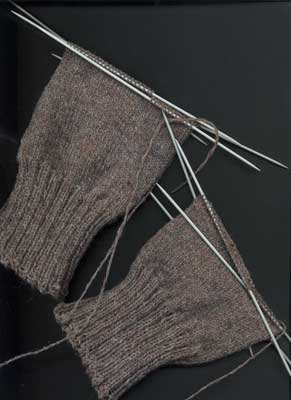
The thunderstorms yesterday evening were a light version of what we seem to be getting this morning. I slept in late, until almost 9 am, but woke up to find the sky was greenish dark gray, and soon a downpour started. There was a strong wind from the northwest too, coming in my window. So, the usual routine has been broken. Instead of checking email and my Apache server logs, I am off-line enjoying a morning cup of tea and writing.
The scan shows how far I got on the socks yesterday. So far I have used photos, but by knitting 12 of the stitches onto a fourth sock needle, I can fold them so that they lay flat on the scanner bed. This is a good "stopping place" especially once the work gets longer as you can roll the sock around the needles and pop it and your ball of yarn into your knitting bag.
Many people knit to relax. This is where the socks are now. By now my hands have gotten used to the feel of this yarn and I hardly need to look at the stitches. I can feel when the end of a needle approaches, then turn onto the next one and shift into autopilot again. While my hands work, my mind is free. I will record some typical mental chatter.
Unless you knit very tightly, the stitches will appear rather rough until you wash and block the garment, sometimes a few times. I think it is important to knit fairly loosely keeping the hands as relaxed as possible. If your hands ache every time you knit, you won't feel like doing it. I typically use a needle one or two sizes smaller than the recommended one on the label to achieve the same gauge.
When working in the round on a circular needle, every stitch has the same tension on it. On sock needles though, the stitches on either end of the needle bear more tension from turning the "corner" than their "inside" neighbors and so tend to pull out a larger loop.
In a ribbed cuff, the transition stitches will be hidden if you take care to put the break between the last purl stitch of the last ribbing pattern and the first knit stitch of the new repeat.
Once you switch to stockinette though, sometimes you need to make adjustments. Although it is tempting to try to pull the end stitches tight, this is futile as they will just steal slack from their neighbors as you go around. The secret is to adjust the tension on the row below which is off the needle. When starting the new needle, knit the first stitch fairly tightly, but on the second and third stitches, pull on the loop as you pick it up BEFORE you knit it. Often you only need to do this for one or two rows then the stitches will start to lay even.
While I am digressing anyway, perhaps I should talk about what I mean by a cuff. Stockinette stitch, knitting all around, is nice and smooth. It does have the tendancy to curl though. By knitting the first rows in ribbing, (K2 P2) six times on each needle, the edge will lay flat plus the elasticity of the ribbing will cause it to draw in, which will help keep the sock up.
Where you stop the ribbing is a personal choice. You can continue in ribbing all the way around to the ankle then continue it over the top of the foot to within an inch or so of the toe. This is good for wearing with low shoes or sandals and the ribbed cuff will look neat even when it is folded over. These are intended to be boot socks, so I start the stockinette fairly early so that the smooth part extends above the boot top. The idea (remember this is Wisconsin!) is that the top of the sock should be long enough that it overlaps the bottom of your long underwear by several inches. When you pull your trowser leg down over the top of the sock, you don't have gaps of exposed skin.
Well, the thunderstorm seems to have moved on, so time to upload. More tomorrow.